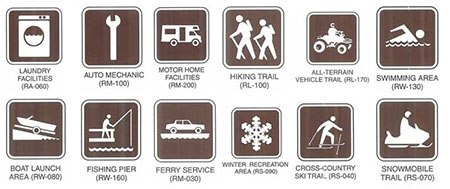InTrans / Aug 25, 2014
Seeing the signs: finding meaning behind traffic control signs
Go! Magazine
 posted on August 25, 2014
posted on August 25, 2014
Remember when you were a kid and you and your kid brother made a game out of guessing what each road sign “actually meant?” Have you ever mistaken a “No Parking” sign for a “No Pets Allowed” sign? And the figure in a “Flagger Ahead” sign does resemble a NASCAR flagmen, right? Either way, being all grown up now, you may have noticed that there are a lot of different kinds of road signs, which are also known as traffic signs or traffic control signs.
Sign Factors
Road signs are not arbitrary. There are several factors that determine how effective or necessary they are, all of which are considered before any sign is placed. Everything about them, including shape, color, height, placement, etc. is carefully considered and researched.
Fulfilling a need
Signs can be useful. However, on any given route, drivers are bombarded with hundreds of pieces of information. So before a sign is placed, the area is studied by traffic engineers to determine if adding a sign will make driving safer and easier.
Getting attention
A sign that can’t be seen or is ignored by drivers is ultimately useless. It is important for drivers to pay attention to signs like stop signs or a pedestrian crossing sign, because it keeps people safe. All signs, at least in the US and parts of Europe, are standardized, meaning they have minimum size, shape, color, and height requirements. This way, regardless of the type of vehicle, they will be seen.
Conveying a message quickly and efficiently
Drivers don’t have time to read more than a few words, because reading any more than that could distract from the road. Signs must convey their meaning quickly and efficiently while leaving no room for doubt or alternative interpretations.
Being respected/enforced
If people choose to ignore road signs, they could be punished by law enforcement. Road signs are there to keep people safe and if drivers start ignoring them, collisions, injuries, and fatalities will occur.
Giving enough time to respond
Depending on the speed, drivers need more time to react. For example, most stop signs in rural areas have additional signs posted well before the stop sign, alerting drivers that there is a stop sign ahead. The same goes for signs that are around bends and curves.
Why are signs designed like that?
Aren’t road signs just….a bit weird looking? When a sign is designed, what really matters is if it’s effective. Take a stop sign, for example. It has a unique shape, an octagon, so it stands out and cannot be mistaken for anything else. And it’s red because the human eye picks red out better than any other color. Red also remains vivid, even on cloudy, rainy, or snowy days (unless it’s a white-out, then, of course, it’s just white.) Another example are “warning signs.” These signs tend to be bright yellow or yellow-orange in color. These colors, like red, stand out and are considered “hot” colors. “Cool” colors are considered to be blue, green, and purple. The same is true of construction signs, which are typically orange. These signs are meant to stand out, because they alert the driver to upcoming road work.
Symbols
A picture is worth a thousand words! Symbols are the most important feature of road signs, because drivers cannot spend time reading! Road signs use commonly understood symbols to convey meaning more quickly and efficiently than words. Some will have a word or two on or below the sign, but most symbols are common enough they can stand alone without words. They’re especially useful as they overcome language barriers and, as a result, some signs (like stop signs) have become universal.

What do sign colors mean?
- Yellow = General warning
- Red/White = Regulation These signs indicate that a driver must stop, yield, or do what is shown on the sign.
- Green = Direction These signs indicate where a place is or how far a place is from where you are.
- Blue = Services for travelers These signs direct you to places like rest areas, tourist sites, hospitals, hotels, gas stations, eating places, campgrounds, or picnic areas.
- Brown = Recreation and cultural points of interest These signs point out historical sites, parks, or recreational areas.
- Orange = Temporary/road construction work, temporary traffic control, and maintenance Drivers should always watch for workers on the road!
Think you know about traffic signs? Play this game to test your knowledge: https://driversed.com/games/dmv-game.aspx
By Brandon Hallmark, Go! Staff Writer